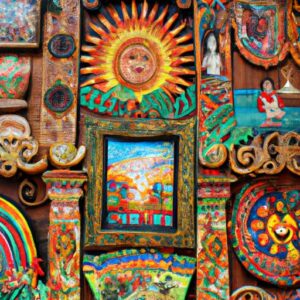Welcome! Have you ever been captivated by a mesmerizing dance performance, a powerful theater act, or the enchanting melodies of a symphony? These captivating forms of art fall under the umbrella of Visual Performing Arts. In this article, we will delve into the world of Visual Performing Arts, exploring its definition, significance in society, and the various forms it encompasses. So, let’s take a step into this vibrant realm where creativity and expression converge!
A. Definition of Visual Performing Arts
Visual Performing Arts can be defined as a dynamic and expressive form of art that combines visual aesthetics with live performances. It involves the artistic representation of emotions, stories, and ideas through the fusion of movement, sound, and visual elements. This multifaceted art form encompasses dance, theater, and music, enabling performers to communicate and connect with the audience on a profound level.
B. Importance of Visual Performing Arts in Society
Visual Performing Arts play a vital role in society, transcending cultural boundaries and enriching human experiences. They serve as a powerful medium of communication, allowing artists to convey messages, challenge societal norms, and provoke thought. Through their performances, artists evoke emotions, inspire dialogue, and foster a sense of unity among diverse communities.
Moreover, Visual Performing Arts contribute to personal and social development. They nurture creativity, discipline, dedication, and self-expression, empowering individuals to explore their own unique talents. Additionally, these art forms provide a platform for storytelling, preserving cultural heritage, and celebrating human diversity.
In a world where technology often dominates our lives, Visual Performing Arts offer a respite, reminding us of the beauty and power of human connection. They have the ability to transport us to different eras, evoke nostalgia, and create lasting memories. So, whether you are an artist, an enthusiast, or simply curious, let’s embark on a journey to unravel the wonders of Visual Performing Arts together!
Stay tuned for the upcoming sections where we will explore the history and evolution of Visual Performing Arts, delve into its various forms, uncover the skills and techniques involved, and discover the myriad benefits it offers. Let the curtain rise on this extraordinary world of creativity and expression!
History and Evolution of Visual Performing Arts
A. Origins of Visual Performing Arts
The roots of Visual Performing Arts can be traced back to ancient civilizations, where artistic expression intertwined with rituals and ceremonies. Dance, as one of the earliest forms, was used to communicate stories, celebrate harvests, and honor gods. The ancient Egyptians, Greeks, and Romans embraced these art forms, incorporating music, dance, and theater into their cultural practices.
B. Influences and Developments over Time
Over the centuries, Visual Performing Arts have evolved and been influenced by various factors. The Renaissance period witnessed a resurgence of interest in classical arts, leading to the emergence of ballet as a refined form of dance. In the 20th century, the advent of technology brought new possibilities, giving rise to experimental and avant-garde performances.
Art movements, such as surrealism and expressionism, also left their mark on Visual Performing Arts, pushing boundaries and challenging traditional artistic norms. The fusion of different cultures and the exchange of ideas across borders have further enriched these art forms, leading to cross-cultural collaborations and innovative performances.
Today, Visual Performing Arts continue to evolve and adapt to the changing times. Artists blend traditional techniques with contemporary influences, creating unique and groundbreaking works. With the advent of digital media, performances can now be shared and experienced globally, transcending physical boundaries.
The history and evolution of Visual Performing Arts showcases the resilience and adaptability of these art forms. They have stood the test of time, continuously evolving to reflect the social, political, and cultural contexts of different eras. Join me in the next section as we explore the captivating forms of Visual Performing Arts, from the graceful movements of dance to the captivating narratives of theater.
Exploring the Diverse Forms of Visual Performing Arts
From graceful movements that tell stories to melodious compositions that stir the soul, Visual Performing Arts encompass a rich tapestry of artistic expressions. Let’s dive into the different forms that make up this captivating world.
A. Dance: The Poetry of Movement
1. Ballet: Grace, Precision, and Elegance
Ballet, with its roots deeply entrenched in the 15th-century Italian Renaissance courts, is a form of dance that epitomizes grace, precision, and elegance. It combines intricate footwork, flowing movements, and expressive storytelling to create a visual spectacle that enchants audiences worldwide.
2. Contemporary Dance: Pushing Boundaries and Embracing Fluidity
Embracing innovation and experimentation, contemporary dance breaks free from the traditional constraints of ballet. It pushes boundaries, explores unconventional movements, and delves into personal narratives, often tackling social and political themes. Contemporary dance celebrates fluidity, diversity, and individual expression.
3. Folk Dance: Celebrating Cultural Heritage and Identity
Folk dance is deeply rooted in cultural traditions and serves as a celebration of heritage and identity. Passed down through generations, folk dances embody the customs, rituals, and stories of specific communities. From energetic Irish jigs to vibrant Indian classical dances, folk dance is a powerful testament to the richness and diversity of human culture.
B. Theatre: Unleashing the Power of Storytelling
1. Acting: Breathing Life into Characters
Acting is the cornerstone of theatrical performances. Through the art of embodying characters, actors immerse themselves in stories, allowing the audience to suspend disbelief and connect with the narratives on a visceral level. With their mastery of voice, body language, and emotional depth, actors bring scripts to life, evoking laughter, tears, and introspection.
2. Stage Design: Crafting Visual Spectacles
Behind every captivating theatrical production lies the intricate art of stage design. This includes set design, lighting, costumes, and props, which work harmoniously to create immersive environments. Stage designers are the architects of the visual world, transforming empty spaces into fantastical realms or realistic backdrops that transport the audience into new realms of imagination.
3. Puppetry: The Enchanting World of Inanimate Performers
Puppetry is a unique form of theater that brings inanimate objects to life. Puppeteers skillfully manipulate puppets, infusing them with personality and emotions. From hand puppets to marionettes and shadow puppets, this art form captivates audiences of all ages, creating enchanting stories that blur the line between reality and fantasy.
C. Music: The Harmonious Language of Emotion
1. Classical Music: Timeless Elegance and Complexity
Classical music, with its rich history and intricate compositions, is a genre that transcends time and space. Composers like Mozart, Beethoven, and Bach have left an indelible mark, crafting symphonies, concertos, and operas that evoke a wide range of emotions. Classical music embodies elegance, complexity, and a profound connection with the human spirit.
2. Jazz: The Soulful Melodies of Improvisation
Jazz, born from the African American communities in the late 19th century, is a genre characterized by its improvisation, syncopation, and swing rhythms. It showcases individual expression, collective collaboration, and a deep connection to the roots of American culture. Jazz musicians use their instruments to tell stories, creating a vibrant and soulful musical experience.
3. Opera: The Fusion of Music and Theater
Opera, often referred to as the “Gesamtkunstwerk” or total work of art, combines music, theater, and storytelling. It showcases the power of operatic voices, intricate compositions, and grand theatrical productions. With its soaring arias and dramatic narratives, opera creates a multisensory experience that leaves audiences awe-inspired.
In the upcoming sections, we will explore the skills and techniques involved in Visual Performing Arts, delve into the benefits of engaging in these art forms, and conclude our exploration with a reflection on the significance of Visual Performing Arts in our lives. So, let’s continue our journey through this captivating realm of creativity and expression!
Skills and Techniques in Visual Performing Arts
Visual Performing Arts require a mastery of various skills and techniques to bring performances to life. From graceful movements to captivating vocals and instrumental prowess, artists in this realm strive for excellence. Let’s explore some of the key skills and techniques involved:
A. Physicality and Body Movement
In the realm of dance and theater, physicality and body movement are paramount. Through years of training and practice, dancers and actors develop exceptional control over their bodies, mastering techniques like balance, flexibility, and coordination. They learn to communicate emotions and narratives through precise gestures, fluid movements, and dynamic expressions. Each graceful step, every nuanced gesture, tells a story, captivating the audience and leaving an indelible impact.
B. Vocal Training and Voice Projection
For those involved in theater and music, vocal training is crucial. Actors and singers undergo rigorous training to develop their vocal range, projection, and control. They learn to modulate their voices to convey a wide range of emotions, captivating the audience with their expressive delivery. Techniques such as diaphragmatic breathing, vocal warm-ups, and proper articulation enhance their ability to communicate effectively and create a powerful impact on stage.
C. Musical Instrument Proficiency
In the realm of music, instrumental proficiency is vital. Musicians spend countless hours honing their skills, learning to play various instruments with precision and artistry. Whether it’s the delicate strokes of a violin bow, the rhythmic beats of drums, or the melodic strumming of a guitar, mastery of an instrument allows musicians to express their innermost thoughts and evoke deep emotions. It is through their skillful playing that melodies come alive, resonating with the audience and leaving a lasting impression.
These skills and techniques require dedication, discipline, and continuous practice. Artists in the Visual Performing Arts realm strive for perfection, constantly pushing the boundaries of their abilities. The culmination of these skills and techniques creates performances that are captivating, immersive, and unforgettable.
In the upcoming sections, we will explore the benefits of engaging in Visual Performing Arts, highlighting the personal, social, and cognitive advantages that these art forms offer. So, stay tuned, as we uncover the transformative power of Visual Performing Arts in our lives!
Benefits of Engaging in Visual Performing Arts
Engaging in Visual Performing Arts extends far beyond mere entertainment; it has a profound impact on personal growth, social connections, and cognitive abilities. Let’s explore the numerous benefits that immersing oneself in these art forms can bring.
A. Personal Development
Visual Performing Arts provide a unique platform for personal development, nurturing valuable skills and qualities that extend beyond the stage. By participating in activities such as dance, theater, or music, individuals develop discipline, perseverance, and self-confidence. The rigorous training involved in these art forms instills a strong work ethic, teaching individuals the value of dedication and practice.
Furthermore, the exploration of personal expression through Visual Performing Arts allows individuals to discover and embrace their own unique identity. Whether it’s through graceful dance movements, emotive acting, or soulful musical performance, these art forms enable individuals to express their thoughts, emotions, and experiences in a powerful and cathartic way.
B. Social and Emotional Well-being
Participating in Visual Performing Arts fosters social connections and emotional well-being. Collaborative experiences, such as group rehearsals and ensemble performances, create a sense of camaraderie and teamwork. Working together towards a common goal cultivates strong bonds among performers, fostering a supportive and inclusive community.
Moreover, Visual Performing Arts provide an outlet for emotional expression and catharsis. Through their performances, artists can communicate and process complex emotions, both for themselves and the audience. This emotional connection promotes empathy, understanding, and introspection, enhancing emotional intelligence and overall well-being.
C. Cognitive and Academic Advantages
Engaging in Visual Performing Arts offers numerous cognitive and academic advantages. Research has shown that involvement in these art forms enhances cognitive abilities such as problem-solving, critical thinking, and creativity. The multidimensional nature of Visual Performing Arts requires performers to think on their feet, adapt to new situations, and make quick decisions, fostering cognitive flexibility and resourcefulness.
Moreover, studies have indicated that students involved in Visual Performing Arts tend to excel academically. The discipline and focus required in these art forms translate into improved concentration, time management, and academic performance. Additionally, the integration of music and movement in learning has been linked to enhanced memory retention and overall cognitive development.
By engaging in Visual Performing Arts, individuals not only reap the intrinsic rewards of artistic expression but also gain valuable life skills, emotional well-being, and cognitive advantages. So, take a leap into this captivating world and unlock the transformative power of Visual Performing Arts!
Stay tuned for the concluding section where we will summarize the significance of Visual Performing Arts and provide encouragement to explore and appreciate this vibrant art form.
Conclusion
In conclusion, Visual Performing Arts are a testament to the boundless creativity and expressive power of humanity. Through dance, theater, and music, artists captivate audiences, provoke emotions, and ignite imaginations. The fusion of visual aesthetics with live performances creates a dynamic and immersive experience that transcends language barriers and touches the deepest parts of our souls.
From the origins of Visual Performing Arts to their evolution over time, we have witnessed the enduring impact they have had on society. These art forms have the ability to challenge societal norms, preserve cultural heritage, and inspire social change. They provide a platform for individuals to explore their creativity, develop their skills, and find their unique voice.
Engaging in Visual Performing Arts offers numerous benefits. It fosters personal development by nurturing discipline, self-expression, and confidence. It promotes social and emotional well-being by fostering connections, empathy, and a sense of belonging. Additionally, studies have shown that participation in Visual Performing Arts can enhance cognitive abilities, improve academic performance, and develop critical thinking skills.
As we conclude our exploration of Visual Performing Arts, I encourage you to embrace and appreciate the beauty and significance of this art form. Attend live performances, support local artists, and explore your own creativity through dance, theater, or music. Let Visual Performing Arts become a part of your life, enriching your experiences and connecting you with the profound depths of human expression.
Thank you for joining us on this journey into the world of Visual Performing Arts. May the arts continue to inspire and uplift us, transcending boundaries and celebrating the diversity of the human spirit.





